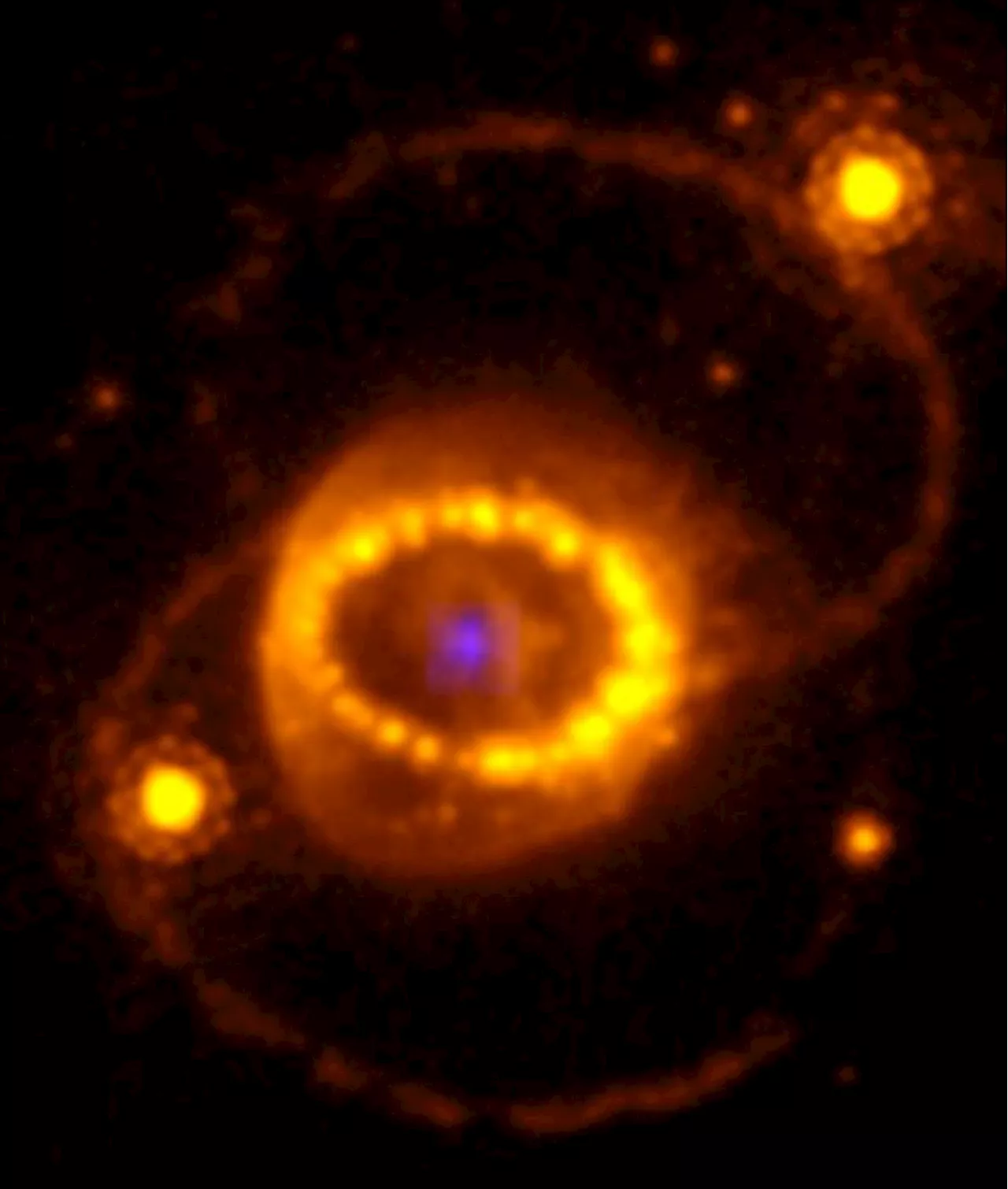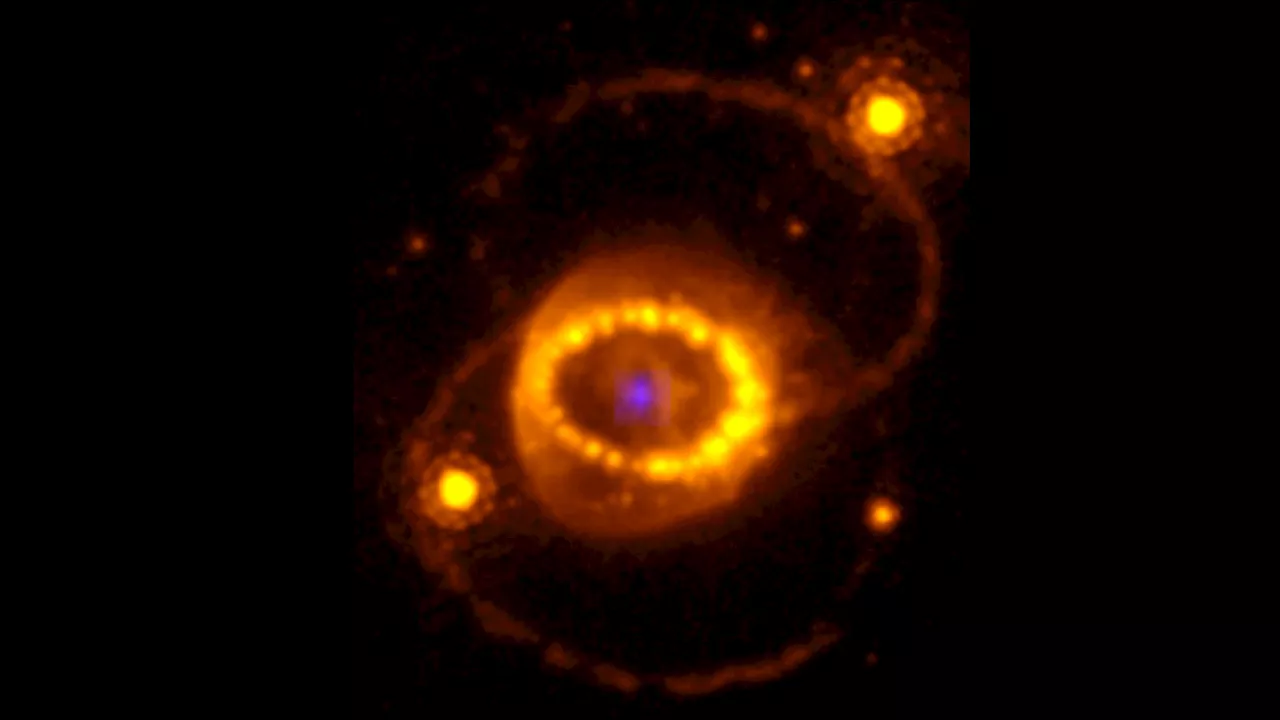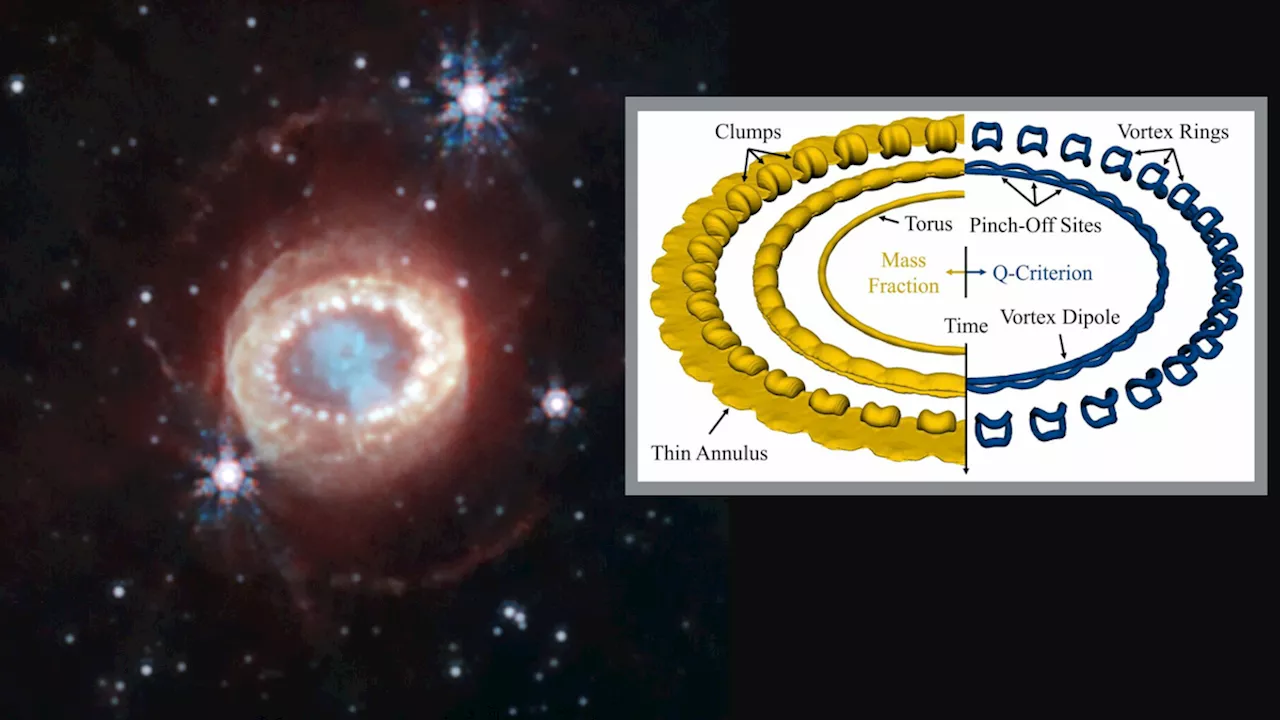There may be an explanation for the appearance of a 'string of pearls' around Supernova 1987a in the Large Magellanic Cloud.
A JWST NIRCam view of Supernova 1987a showing its string of pearls. The keyhole-shaped material at the heart is ejecta from the explosion. NASA, ESA, CSA, Mikako Matsuura , Richard Arendt , Claes Fransson , Josefin Larsson
Today, astronomers look at the site of the stellar catastrophe and see an expanding, glowing ring of light. Over the years, its shape has changed to a clumpy-looking string of pearls. What’s happening to affect its appearance? The answer lies in something called the “Crow Instability.” We see this aerodynamical process when vortexes off the wingtips of airplanes interact with the contrails from their engines. The instability breaks up the contrail into a set of vortex “rings”.
The expanding ring-shaped remnant of SN 1987A and its interaction with its surroundings, seen in X-ray and visible light. The star that became SN 1987a expelled concentric rings of material during its red and blue supergiant phases, and the shockwave from the supernova lit them up. Image: Public Domain, https://commons.wikimedia.org/w/index.php?curid=278848Light and neutrinos from Supernova 1987a reached Earth on February 23, 1987.
A simulation shows the shape of the gas cloud on the left and the vortices, or regions of rapidly rotating flow, on the right. Each ring represents a later time in the evolution of the cloud. The gas cloud starts as an even ring with no rotation. It becomes a lumpy ring as the vortices develop. Eventually, the gas breaks up into distinct clumps.
United Kingdom Latest News, United Kingdom Headlines
Similar News:You can also read news stories similar to this one that we have collected from other news sources.
 A Neutron Star Rests at Supernova 1987A’s CenterThe supernova has astonished experts since its discovery almost four decades ago
A Neutron Star Rests at Supernova 1987A’s CenterThe supernova has astonished experts since its discovery almost four decades ago
Read more »
 JWST spies hints of a neutron star left behind by supernova 1987ASigns of highly ionized atoms in dusty clouds at SN 1987A’s explosion site suggest a powerful source of X-rays — likely a neutron star — lurks within.
JWST spies hints of a neutron star left behind by supernova 1987ASigns of highly ionized atoms in dusty clouds at SN 1987A’s explosion site suggest a powerful source of X-rays — likely a neutron star — lurks within.
Read more »
 Scientists may finally know why this infamous supernova wears a 'string of pearls'Robert Lea is a science journalist in the U.K. whose articles have been published in Physics World, New Scientist, Astronomy Magazine, All About Space, Newsweek and ZME Science. He also writes about science communication for Elsevier and the European Journal of Physics. Rob holds a bachelor of science degree in physics and astronomy from the U.K.
Scientists may finally know why this infamous supernova wears a 'string of pearls'Robert Lea is a science journalist in the U.K. whose articles have been published in Physics World, New Scientist, Astronomy Magazine, All About Space, Newsweek and ZME Science. He also writes about science communication for Elsevier and the European Journal of Physics. Rob holds a bachelor of science degree in physics and astronomy from the U.K.
Read more »
 Finally! Webb Finds a Neutron Star from Supernova 1987ASpace and astronomy news
Finally! Webb Finds a Neutron Star from Supernova 1987ASpace and astronomy news
Read more »
 Webb finds evidence for neutron star at heart of young supernova remnantNASA's James Webb Space Telescope has found the best evidence yet for emission from a neutron star at the site of a recently observed supernova. The supernova, known as SN 1987A, was a core-collapse supernova, meaning the compacted remains at its core formed either a neutron star or a black hole.
Webb finds evidence for neutron star at heart of young supernova remnantNASA's James Webb Space Telescope has found the best evidence yet for emission from a neutron star at the site of a recently observed supernova. The supernova, known as SN 1987A, was a core-collapse supernova, meaning the compacted remains at its core formed either a neutron star or a black hole.
Read more »
 Explaining a supernova's 'string of pearls'Physicists often turn to the Rayleigh-Taylor instability to explain why fluid structures form in plasmas, but that may not be the full story when it comes to the ring of hydrogen clumps around supernova 1987A, research suggests.
Explaining a supernova's 'string of pearls'Physicists often turn to the Rayleigh-Taylor instability to explain why fluid structures form in plasmas, but that may not be the full story when it comes to the ring of hydrogen clumps around supernova 1987A, research suggests.
Read more »
